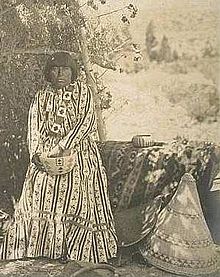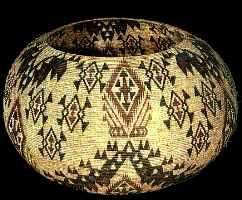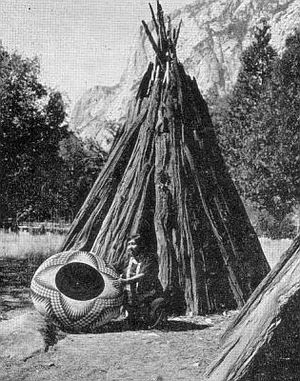Kucadikadi facts for kids

Nellie Charlie, a member of the Kucadikadi band, early 20th century
|
|
| Regions with significant populations | |
|---|---|
| Languages | |
| Northern Paiute language, English language | |
| Religion | |
| Traditional tribal religion, Shamanism | |
| Related ethnic groups | |
| other Northern Paiute people, Mono tribe (including Owens Valley Paiute), Western Shoshone, Yokuts |
The Kucadɨkadɨ are a group of Native American people. They are part of the larger Northern Paiute tribe. These people have lived for a long time near Mono Lake in Mono County, California. They are the southernmost group of Northern Paiute people.
Contents
What's in a Name?
The name Kucadɨkadɨ means "eaters of the brine fly pupae." Brine fly pupae are like tiny insect cocoons. They were an important food for these people. The Kucadɨkadɨ are also known by other names. These include Kutsavidökadö and Mono Lake Paiute. The people themselves call their group Kootzaduka’a.
The name "Mono" comes from a different tribe, the Yokuts. The Yokuts called the people near Mono Lake "fly people." This was because fly larvae were a main food source. This name later became confusing. It was used for both the Kucadɨkadɨ and other nearby groups. But the name "Mono" also stayed with the lake itself.
Some history connects the Kucadɨkadɨ to the Yosemite area. Chief Tenaya's group, who lived in Yosemite, is believed to have come from the Mono Lake area.
Life in the Mono Lake Area
The Kucadɨkadɨ people lived around Mono Lake in eastern California. This area is a high plain at the base of the Sierra Nevada mountains. The lake is around 6,400 feet (2,000 m) above sea level. The mountains nearby are very tall, ranging from 9,000 to 13,000 ft (2,700 to 4,000 m) in elevation.
Mono Lake's Unique Environment
Mono Lake is very salty, much saltier than the ocean! Many kinds of water birds live there. It is also home to the brine fly, or Ephydra hians. These flies were a key food source for the Kucadɨkadɨ, giving them their name.
Food and Shelter
Besides brine flies, the Kucadɨkadɨ ate many other foods. They gathered nuts from the Pinus monophylla or piñon pine trees. They also hunted animals like jackrabbits, deer, and mountain sheep. The caterpillars of the Pandora moth were another food source.
Families were the main social groups. These families often moved together to find food. They also traded goods with other tribes, like the Owens Valley Paiute and Western Mono.
Archaeologists have found old winter homes of the Kucadɨkadɨ. These homes were cone-shaped. They were built using posts from Utah juniper trees. These special winter houses were called tomogani. People built them until about 1920.
The Kucadɨkadɨ Language
The Kucadɨkadɨ people speak the Northern Paiute language. This language belongs to a larger group called the Numic branch. The Numic branch is part of the huge Uto-Aztecan language family.
Many different tribes across the western United States speak Northern Paiute. These tribes live in places like eastern California, Nevada, Oregon, and Idaho. The Northern Paiute language is also related to other languages. These include the Shoshoni language and the languages of the Kawaiisu and Ute people.
Amazing Basket Weavers

The Kucadɨkadɨ are famous for their amazing baskets. They made two main types: coiled baskets and twined baskets. They used plants like Bracken fern and redbud to add colorful designs to their coiled baskets.
In the late 1800s and early 1900s, life changed for the Kucadɨkadɨ. More non-Native people moved into their lands. This made it harder to continue their traditional hunting and gathering. So, many Kucadɨkadɨ people started selling their beautiful baskets to tourists. This helped them earn a living.
Around 1908, glass beads became available. Kucadɨkadɨ women then started adding these tiny beads into their basket designs.
The Kucadɨkadɨ Today
Today, many Kucadɨkadɨ people are part of other recognized tribes. These include the Bishop Paiute, Washoe, Yokut, Miwok, and Western Mono tribes. These tribes are officially recognized by the government.
Other Kucadɨkadɨ members are working to gain recognition for their own groups. These groups include the Sierra Southern Miwuk and the Mono Lake Indian Community. The Mono Lake Indian Community is based in Lee Vining, California.
Famous Kucadɨkadɨ People

Many talented Kucadɨkadɨ individuals have made important contributions. Here are some notable people, especially known for their amazing basket weaving skills:
- Carrie Bethel (1898–1974), a skilled basket weaver
- Nellie Charlie (1867–1965), also a renowned basket weaver
- Tina Charlie (1869–1962), another gifted basket weaver
- Lucy Telles (born around 1870 or 1885, died 1955 or 1956), a very famous basket weaver

